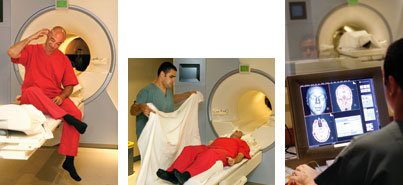One man's journey through an MRI
One man's journey through an MRI McGill University
User Tools (skip):
One man's journey through an MRI

Michael Bourguignon inserts earplugs (left) prior to being tucked in for his MRI by chief technician David Costa (centre). Will the results show normal brain activity (right)?
Owen Egan
I've often been told I should have my head examined. The suggestion tends to come from girlfriends in the heat of argument, so it's been easy enough for me to dismiss it as poppycock. After all, I couldn't possibly be on the wrong side of an argument, could I?
Still, when the opportunity arose to actually have my brain scanned by a Magnetic Resonance Imaging (MRI) machine, an intriguing offer made during a recent fact-finding mission at the Montreal Neurological Institute, it proved an offer I couldn't refuse.
At the very least, I relished the thought of walking out of the MNI with a glossy MRI image of my brain, suitable for framing and wallet-sized toting.
Turns out I'm not the only one to think this way. "Everyone wants a printout to show their friends," says Pedro Rosa-Neto, the MNI researcher whose study I've signed up for. As I suspect, you can't just take the MNI guys out for a few beers and then go back to the lab and have your brain scanned for kicks. If I want to experience what many people dread — the claustrophobic doom tube of the MRI machine — I will have to sign up as a volunteer subject in a bona fide scientific study.
Theft-proof gowns
Rosa-Neto has several such studies on the go. The one I've signed up for is two-pronged. The MNI is building a database of images and data on "normal" adult brains, defined as disease-free and 20 to 40 years old, to use as a comparative template when researching neurological diseases. He is also interested in recording neurological responses to stimuli, which is why, at one point in my MRI experience, a cylinder will be placed in my hand and will vibrate at regular intervals. The MRI will record how my brain reacts to the sensation. I just wanna see a picture of my brain.
But is it safe?
"The magnetic field is not strong enough to disrupt any molecules," he assures me, likening the process to a long, slow x-ray.
Rosa-Neto introduces me to André Cormier, chief technician of the MRI department, who has been with the MNI since the brain-imaging centre was built in 2002. Cormier escorts me to the change room, where I don an offensively hot pink surgical gown. "We make them pink so no one steals them," he tells me with a wink.
Then he leads me through sliding doors to the MRI centre, where I'm greeted by David Costa, the I've-done-this-countless-times-before smiling technician who will sit in a glassed-in room adjoining the MRI room and monitor the proceedings on a laptop. He also designed the nifty vibrotactile stimulator I'll clutch in my hand.
Ear plugs and a cosy blanket
Costa gives me a set of earplugs ("Why? Is the machine loud?" I ask. "You'll be fine," he says with that reassuring smile), hands me a shower cap and instructs me to lie down. He fits a foam cushion under my knees, places a panic button in my hand and tells me that, in the event of an "emergency," all I have to do is press the button and the cavalry will appear. He then drapes a cosy white blanket over my body and, somewhat less cosily, a sort of helmet that locks my head in place and that Rosa-Neto later explains is the antenna that helps translate the magnetic waves of the MRI machine into an image that will show both the grey matter and the connective white matter of my brain. Also inside the helmet is a mirror angled to allow me to see the technician in the other room.
"Ready? Here we go," says Costa. I close my eyes as my body enters the chamber, aware that I'll be in this position for the next two hours, unable to move and trying valiantly not to panic at the thought.
I open my eyes and look around. This is not so bad, a little disorienting and, yes, claustrophobic but not intolerable. Then the machine kicks in, making a hellish sound like a jackhammer. It continues like this throughout the two-hour session. Still, I'm able to relax enough to eventually find myself in a weird place between sleep and wakefulness with a jackhammer in my head.
"I need you to stay awake," Rosa-Neto politely calls over the intercom.
Sorry about that.
Two hours pass in what seems like hardly any time at all and I re-emerge none the worse for wear. I'm tired, a little disoriented, but apart from the noise, this is not what I would call an unpleasant experience.
Now I'm just wondering if they found anything untoward. Turns out there were no irregularities, no off-putting black spots, all the grey and white where it should be.
"You have a beautiful brain," Rosa-Neto tells me. The perfect comeback line, next time someone tells me to have my head examined.

